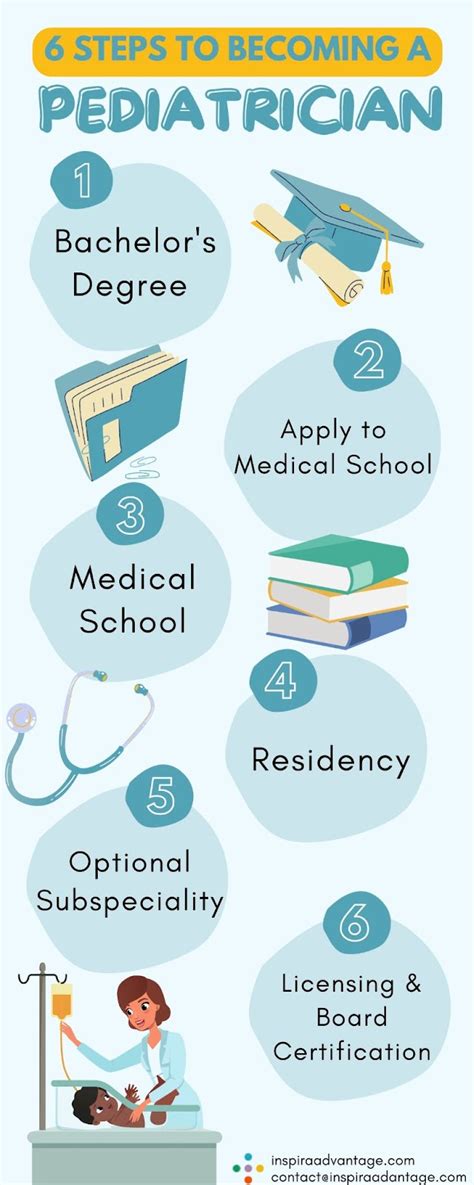Introduction

The path to becoming a pediatrician, a highly specialized medical professional dedicated to the health and well-being of children, is a multifaceted journey that encompasses years of rigorous education and training. This article delves into the intricate details of the process, outlining the number of years required at each stage and highlighting key milestones along the way.
Steps to Becoming a Pediatrician
The path to becoming a pediatrician consists of four distinct stages:
- Undergraduate Education
- Medical School
- Residency Program
- Board Certification
Stage 1: Undergraduate Education
Years Required: 4
The first step in becoming a pediatrician is to obtain a bachelor’s degree. While any undergraduate major is acceptable, most aspiring pediatricians choose to pursue pre-medical or science-related coursework to strengthen their foundational knowledge.
Stage 2: Medical School
Years Required: 4
After completing an undergraduate degree, individuals must enroll in medical school. Medical school is a rigorous academic program that provides students with a comprehensive understanding of medical principles, human anatomy, and disease management.
Stage 3: Residency Program
Years Required: 3
Upon completing medical school, aspiring pediatricians enter a three-year residency program in pediatrics. This program provides hands-on clinical experience under the supervision of experienced physicians. Residents rotate through various hospital services, treating a wide range of pediatric illnesses and conditions.
Stage 4: Board Certification
Years Required: 1 (after residency)
After completing residency, pediatricians must complete an additional year of clinical practice and pass a national board certification exam to become board-certified. Board certification ensures that pediatricians possess the necessary knowledge and skills to practice independently.
Total Years Required: 12+
The total number of years required to become a pediatrician is approximately 12 or more. This includes the four years of undergraduate education, four years of medical school, three years of residency, and one additional year of post-residency practice and board certification.
Key Milestones and Considerations
- Medical College Admission Test (MCAT): Required for admission to medical school.
- Residency Matching Program: Competitive process where medical students match with residency programs.
- Board Certification Exam: Comprehensive examination required for board-certified status.
- Continuing Medical Education (CME): Ongoing education required to maintain board certification.
Why Does it Matter?
Becoming a pediatrician is a significant commitment of time and effort. However, it is a highly rewarding career that offers the opportunity to make a meaningful impact on the lives of children. Pediatricians play a vital role in ensuring the health and well-being of our future generations.
Benefits of Becoming a Pediatrician
- Job Security: Pediatricians are in high demand due to the increasing population of children.
- Meaningful Work: Making a difference in the lives of children is a fulfilling and rewarding experience.
- Intellectual Stimulation: Pediatrics is a dynamic field that requires continuous learning and knowledge acquisition.
- Career Growth Opportunities: Pediatricians can pursue subspecialties or leadership roles within the field.
Tips and Tricks
- Start early: Prepare for medical school and residency by excelling in undergraduate academics.
- Join pre-medical societies: Network with other aspiring medical professionals and gain valuable insights.
- Volunteer in healthcare settings: Gain hands-on experience and demonstrate your commitment to the field.
- Shadow pediatricians: Observe the day-to-day work of pediatricians to gain a deeper understanding of the profession.
- Seek mentorship: Find experienced pediatricians who can provide guidance and support throughout your journey.
Common Mistakes to Avoid
- Underestimating the time commitment: The path to becoming a pediatrician is lengthy and requires significant dedication.
- Neglecting self-care: Maintaining a healthy work-life balance is crucial for success in this demanding field.
- Assuming you know all the answers: Pediatrics is a constantly evolving field, so continuous learning is essential.
- Lacking empathy: Children are vulnerable patients, and pediatricians must possess a genuine compassion for their well-being.
- Failing to communicate effectively: Clear communication with patients, parents, and colleagues is paramount in pediatrics.
Conclusion
Becoming a pediatrician is a transformative journey that requires a significant investment of time, effort, and passion. However, the rewards are immense, as pediatricians play a pivotal role in the health and well-being of children. By meticulously following the outlined steps and embracing the challenges along the way, aspiring pediatricians can embark on a fulfilling and impactful career dedicated to the care of our future generations.
Table 1: Years Required for Each Stage of Pediatric Education
| Stage | Years Required |
|---|---|
| Undergraduate Education | 4 |
| Medical School | 4 |
| Residency Program | 3 |
| Board Certification | 1 (after residency) |
Table 2: Timeline of Pediatric Education
| Age Range | Stage |
|---|---|
| 18-22 | Undergraduate Education |
| 22-26 | Medical School |
| 26-29 | Residency Program |
| 29-30 | Board Certification |
Table 3: Salary Range for Pediatricians
| Location | Salary Range |
|---|---|
| United States | $130,000 – $200,000 |
| United Kingdom | £60,000 – £100,000 |
| Canada | $120,000 – $180,000 |
Table 4: Interesting Facts About Pediatricians
| Fact | Information |
|---|---|
| Number of pediatricians in the United States | Over 60,000 |
| Most common pediatric specialty | General pediatrics |
| Average number of patients seen by a pediatrician per day | 25-30 |
| Percentage of children with a chronic health condition | 15-20% |
